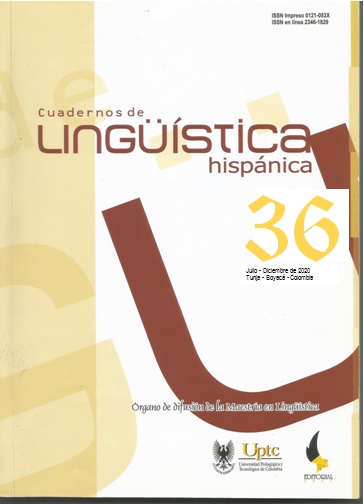Spanish in contact with Korean: New insights into language switching

Abstract
‘Code-switching’ (CS) refers to language-mixing where individuals who speak two or more languages switch from one to another, often mid-sentence. Several morpho-syntactic constraints governing when switches happen have been proposed in prior work, mostly on Spanish-English CS (e.g. Timm, 1975; Pfaff, 1979; Poplack, 1980). However, what happens when the languages are typologically different? This is the case with Spanish-Korean CS, which has not been systematically investigated. Korean and Spanish differ in many respects, including clause structure/word order, absence/presence of articles, and morphology (Korean: agglutinative, Spanish: fusional) (Kwon, 2012; Bosque, Demonte, Lázaro, Pavón & Española, 1999). For the present study, balanced Spanish-Korean bilinguals were interviewed to obtain a naturalistic corpus of CS. Strikingly, we find that many constraints proposed for Spanish-English CS do not hold for Spanish-Korean. Specifically, there are three main ways that Spanish-Korean CS violates the constraints proposed for Spanish-English: (i) in contexts involving word order/clause structure, (ii) on the level of nouns and (iii) on the level of morphemes. Crucially, the violations are not random: We suggest that they stem from the typological differences between Korean and Spanish. This work highlights the empirical and theoretical benefits of including typologically diverse language pairs when investigating CS.
Keywords
Spanish-Korean, code-switching, bilingualism, typology, Free Morpheme Constraint
References
Abney, S. (1987). The English Noun Phrase in its Sentential Aspect. Ph.D. Dissertation, MIT.
Alexiadou, A. (2017). Building verbs in language mixing varieties. Zeitschrift für Sprachwissenschaft, 36(1), 165-192. https://doi.org/10.1515/zfs-2017-0008
Alexiadou, A., & Lohndal, T. (2018). Units of language mixing: A cross-linguistic perspective. Frontiers in psychology, 9.
https://doi.org/10.3389/fpsyg.2018.01719
Belazi, H., Rubin, E., Toribio, A. (1994). Code Switching and X-Bar Theory: The Functional Head Constraint. Linguistic Inquiry, 25(2), 221-237.
Berk-Seligson, S. (1986). Linguistic Constraints on Intrasentential Code-switching: A Study of Spanish/Hebrew Bilingualism. Language in Society, 15, 313-348. https://doi.org/10.1017/S0047404500011799
Bosque, I., Demonte, V., Lázaro Carreter, F., Pavón Lucero, M. V., & Española, R. A. (1999). Gramática descriptiva de la lengua española. Espasa.
Chan, B. H. S. (2008). Code-switching, Word Order and the Lexical/Functional Category Distinction. Lingua, 118 (6), 777-809.
https://doi.org/10.1016/j.lingua.2007.05.004
Choi, J. (1991). Korean-English Code-switching: Switch-alpha and Linguistic Constraints. Linguistics, 29, 877-902.
https://doi.org/10.1515/ling.1991.29.5.877
Chomsky, N. (1993). Language and Thought. London: Moyer Bell.
Cummins, J. (1981). The Role of Primary Language Development in Promoting Educational Success for Language Minority Students. Schooling and Language Minority Students: A Theoretical Framework, Sacramento: California State Department of Education, 3-49.
Fishman, J., Cooper, R., Ma, R., et al. (1971). Bilingualism in the Barrio. Indiana University Press.
Fishman, J. A. (1977). The social science perspective. In Bilingual Education: Current Perspectives. Social Science pp. 1- 49. Arlington, VA: Center for Applied Linguistics.
Giancaspro, D. (2013). L2 learners' and heritage speakers' judgments of code-switching at the auxiliary-VP boundary. In Selected Proceedings of the 16th Hispanic Linguistics Symposium, 56-69. Cascadilla Proceedings Project.
Gumperz, J. J. (1977). The Sociolinguistic Significance of Conversational Code-Switching. RELC Journal, 8(2), 1-34.
https://doi.org/10.1177/003368827700800201
Joshi, A. K. (1985). Processing of Sentences with Intrasentential Codeswitching. Natural Language Parsing: Psychological, Computational, and Theoretical Perspectives, Cambridge University Press, 190-205.
https://doi.org/10.1017/CBO9780511597855.006
Kim, S. & Kaiser, E. (2019). English-Korean code-switching: Looking beyond balanced bilinguals and beyond Indo-European. The 25th Architectures and Mechanisms of Language Processing Conference, Moscow, Russia. [talk]
Kwon, J. I. (2012). Hankuke munpepnon (Korean grammar). Seoul: Tae Hak Sa.
MacSwan, J. (1999). A Minimalist Approach to Intrasentential Code Switching. Garland.
McClure, E., & Wentz, J. (1975). Code-switching among Mexican-American Children. Functionalism, Chicago: University of Chicago, 421-432.
Mahootian, S. (1993). A Null Theory of Codeswitching. Doctoral Dissertation, Northwestern University.
Mahootian, S., & Santorini, B. (1996). Code-switching and the Complement/Adjunct Distinction. Linguistic Inquiry, 27(3), 464-479.
Martin, S. E. (1992). Yale romanization. A reference grammar of Korean, 8-12.
McClure, E. (1981). Formal and Functional Aspects of Codeswitched Discourse of Bilingual Children. Latino Language and Communicative Behavior, Ablex, 69-94.
Muntendam, A. (2006). Diglossia, footing and Quechua-Spanish code-switching. In Symposium about language and society.
Nishimura, M. (1985). Intrasentential Code-switching in Japanese and English. Doctoral Dissertation, University of Pennsylvania.
Nishimura, M., & Yoon, K. (1998). Head Directionality and Intrasentential Code-switching: A Study of Japanese Canadians and Korean Americans' Bilingual Speech. Japanese/Korean Linguistics 8, Stanford: CSLI Publications, 121-130.
Osawa, F. (1998). The Emergence of the D System and the Demise of Morphological Case in English. UCL Working Papers in Linguistics, 10, 467-488.
Park, J. (1990). Korean/English Intrasentential Code-switching: Matrix Language Assignment and Linguistic Constraints. Doctoral Dissertation, University of Illinois at Urbana-Champaign.
Park, K. (2016). A Constraint on Lexical Transfer, Journal of The Korea Society of Computer and Information, 21(11), 9-16.
https://doi.org/10.9708/jksci.2016.21.11.009
Pfaff, C. (1979). Constraints on Language Mixing: Intrasentential Code-Switching and Borrowing in Spanish/English. Language, 55, 291-318.
https://doi.org/10.2307/412586
Poplack, S. (1980). Sometimes I'll Start a Sentence in Spanish y termino en español: Toward a Typology of Code-switching. Linguistics, 18(7-8), 581-618.
https://doi.org/10.1515/ling.1980.18.7-8.581
Poplack, S. (1981). Syntactic Structure and Social Function of Codeswitching. Latino Language and Communicative Behavior, Norwood: Ablex, 169-184.
Potowski, K. & Bolyanatz, M. (2012). Reactions to (in)felicitous codeswitching: Heritage speakers vs. L2 learners. In Selected Proceedings of the 14th Hispanic Linguistics Symposium, 116-129. Cascadilla Proceedings Project.
Sánchez, L. (2012). Convergence in syntax/morphology mapping strategies: evidence from Quechua-Spanish code mixing. Lingua, 122(5), 511-528. https://doi.org/10.1016/j.lingua.2011.10.004
Sankoff, D., & Poplack, S. (1981). A Formal Grammar for Code-Switching. Research on Language and Social Interaction, 14(1), 3-45.
https://doi.org/10.1080/08351818109370523
Simpson, A. (2019). Language and Society: An Introduction. Oxford University Press.
Timm, L. A. (1975). Spanish-English Codeswitching: el porqué y How-not to. Romance Philology, 28, 473-482.
Toribio, A. (2001). On the Emergence of Bilingual Code-switching Competence. Bilingualism: Language and Cognition, 4(3), 203-231.
https://doi.org/10.1017/S1366728901000414
Weinreich, U. (1953). Languages in contact. The Hague: Mouton.
Woolford, E. (1983). Bilingual Code-switching and Syntactic Theory. Lingusitic Inquiry, 14(3), 520-536.
Yoon, (1992). New Perspectives in Intrasentential Code-switching: A Study of Korean-English. Applied Psycholinguistics, 13, 433-449.
https://doi.org/10.1017/S0142716400005750